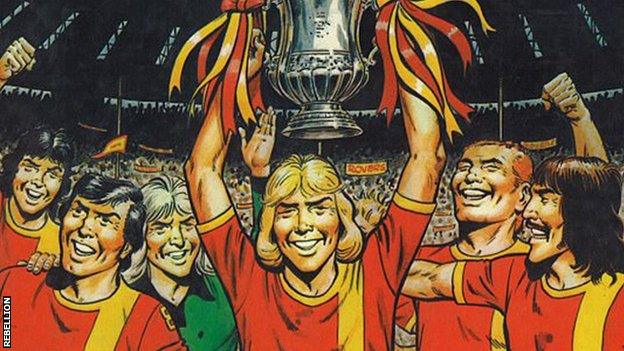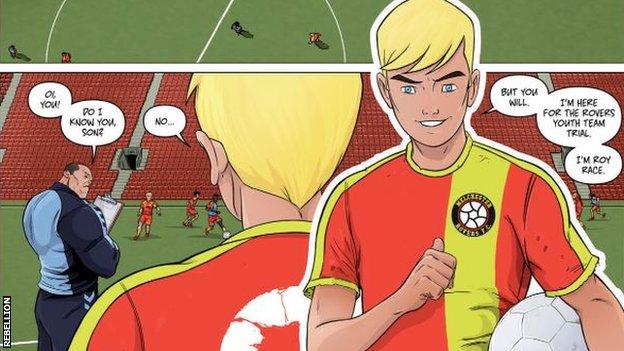Roy of the Rovers: How has Melchester striker stayed relevant 67 years on?
- Published

'Real Roy of the Rovers stuff' - the comic and its hero have become shorthand for the joyous romance of the beautiful game, often said by commentators when an underdog triumphs against the odds
With his clean-cut good looks, innate sense of decency and sportsmanship, and a seriously fierce shot in his locker, Roy Race was always meant to be a positive force on the football field.
It is this as much as anything that has ensured the iconic comic book character's continuing popularity, almost 67 years after he first appeared on the pages of Tiger magazine.
To members of a certain generation, Roy of the Rovers represents childhood escapism and unadulterated joy - the pleasure of poring over a comic depicting the thrilling, often improbable adventures of the striker and his side, Melchester Rovers.
Now, new readers are discovering the joy of Roy thanks to a rebooted series of graphic novels and accompanying fiction books, depicting the adventures of a younger iteration of the character and his equally football-mad sister, Rocky.
With football serving as a distraction from the grimness of reality and high-profile players realising their potency as role models, Melchester's number nine has rarely felt as timely.
'Roy doesn't have a nasty bone in his body'

The rebooted Roy of the Rovers story runs alternately between fiction books and graphic novels - the latter written by Rob Williams, who has also authored comics for both DC and Marvel
First appearing in Tiger on 11 September, 1954, Roy of the Rovers would be a staple and successful part of the comic for 22 years before becoming its own weekly publication, which at its peak shifted over half a million copies.
By 1993, sales had fallen but Roy's story continued, first on a monthly basis and finally as part of the BBC's Match of the Day Magazine, which ended and took him with it in 2001.
There was no shortage of drama. Beyond the remarkable comebacks and last-minute winners, there were kidnappings, a failed assassination, an earthquake at Melchester's ground, a terrorist attack that killed eight of the Rovers side and a helicopter crash which resulted in the amputation of Roy's famed left foot.
What drew people to the story, though, was Roy himself - here was a footballing hero on to whom readers could project themselves, but also a good man from whose trials and tribulations they could learn.
The 2018 reboot brought a shift in perspective, reverting Roy back to a 16-year-old aspiring footballer with real off-field challenges - and a peer to many of his readers.
"He's like every boy who wants to grow up to be a footballer," Tom Palmer, the author of the new novels, tells BBC Sport. "He is a normal lad, who is gifted at football and works hard and wants to get there. It is wish fulfilment but it makes it possible.
"He is still Roy - he is good and kind and when he makes mistakes it is because he is naive. He doesn't have a nasty bone in his body."
A prolific and award-winning children's writer, Palmer is part of a creative team, along with renowned comics author Rob Williams, who writes the accompanying graphic novels, and artists Ben Willsher and Lisa Henke. Between them they craft the new, relatable Roy of the Rovers universe with publishers Rebellion.
To do so, they tap into the world around them and their own experiences.
As a Leeds fan, Palmer used the memories of his side's financial woes and descent into the lower leagues in the first decade of this century to portray a Melchester side that begins the new story as a fallen giant languishing in League Two.
He drew on something even more personal to provide his protagonist with the very real-world challenge of his father suffering the debilitating after-effects of a brain tumour.
"It was 30 years ago and I was a bit older than Roy but what happens with his dad, that happened to my dad," he says.
"It is like writing my own past and it has worked well in the books. It is a coming of age thing - all your childhood you spend playing football with a parent and you're being taken to games by them and then suddenly you're taking them."
'It really feels like boys and girls are equal'

Rocky's name is just one of many nods to the old comics in the new stories. Tom Palmer says: "All the players have names of old players and we put in loads of little references in the books and graphic novels to the old stuff. Like illustrators' names - stuff that will appeal to those that remember it."
A timely alteration in the new books involves Rocky Race, who was Roy's son in the original comics but is now his sister and a superb footballer herself.
The most recent of Palmer's books was named after her, features the tagline "it's a girls' game" and depicts her fight to emerge from the shadow of her now famous older brother.
"Rocky forced her way in," says Palmer. "She was originally this annoying little sister who would burst the professional footballer's bubble. But the trajectory now is that she is going to become a top-flight player herself."
Having worked in schools, Palmer has seen the change in attitude towards girls and football thanks to such positive representations of the women's game.
"I used to do penalty shootouts in school halls and 10-15 years ago girls were a lot more reluctant," he says. "Boys would mock them a bit when they came up to take a penalty. Now that doesn't happen. It really feels like boys and girls are equal.
"This generation has definitely seen a shift in how girls doing or talking about football is perceived. That is why Rocky is such an important thing."
'Football got me into reading'
It is not just football but footballers themselves that have changed markedly from the original Roy's time.
Articles and autobiographies have shone a light on the struggles many faced in their youth, while some are using their platform to fight for real social change, the most high profile being Marcus Rashford and his campaign to tackle child food poverty.
The custodians of the new Roy of the Rovers drew inspiration from this in their quest to make their story not only a reflection of its time but an inspiration to its audience.
"I read the first 50 pages of a lot of footballer autobiographies and a lot of articles," adds Palmer. "Raheem Sterling did one about three or four years ago on his mum and the sacrifices she made., external It massively influenced how I wrote Roy.
"I recommended it to schools, to make kids look at and reassess these superstars, especially Sterling as he was getting so much stick from parts of the media.
"There is that image of him helping his mum clean a hotel. He has to go to school, but has to come with her on the job first. That is how he became who he is.
"Rashford has revealed even more of this to us and in a great way."
There is another significant cross-over between the Manchester United and Melchester strikers - a drive to spread the joy of literature.
In November, Rashford teamed up with Macmillan Children's Books to promote reading and literacy - an issue that is also close to the heart of Palmer, who put together a free football writing guide for last year's first national coronavirus lockdown that is still available on the official Roy of the Rovers website., external
In his role as the Leeds United Foundation's children's writer in residence, Palmer also recently helped with a literary art project that enabled local primary school children from diverse backgrounds tell their stories through a combination of the written word and a painted mural. BBC's Match of the Day were there to film it.
"I didn't like reading as a kid and my mum used Leeds matchday programmes, reports in the Yorkshire Evening Post and Roy of the Rovers to get me going," adds Palmer. "It was because of the love of football that I got into reading."
How Leeds United help the city's schools celebrate diversity

Remembering an icon: Hear how David Bowie always managed to stay ahead of his time
Need a lift?: Joe Wicks and guests are here to bring positivity to your day
